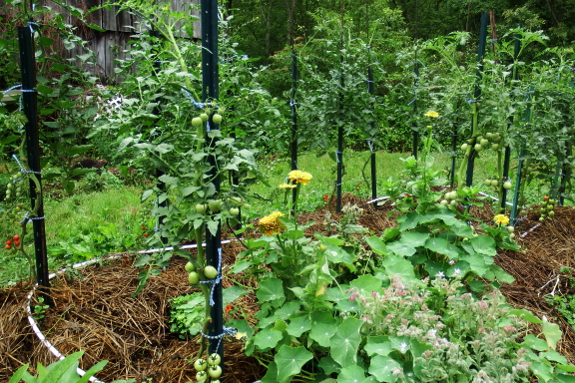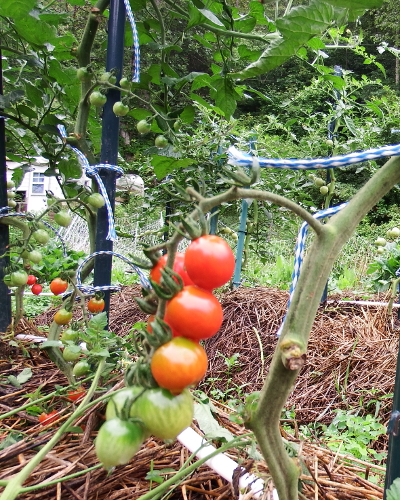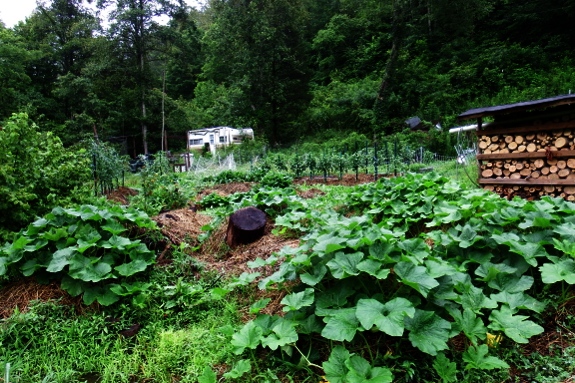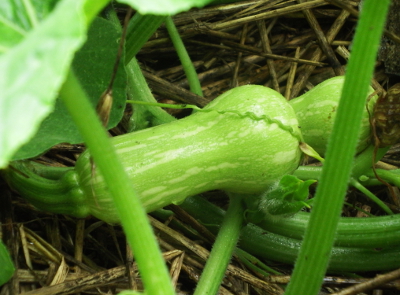
A blight by any other name...

 In
our garden, it's always a case of good news/bad news. Good news: we
started eating our first tomatoes (Jasper) this week and there is
technically still no blight in the patch. Bad news: septoria leaf spot has reared its ugly head and required me to snip off half the plants' leaves anyway.
In
our garden, it's always a case of good news/bad news. Good news: we
started eating our first tomatoes (Jasper) this week and there is
technically still no blight in the patch. Bad news: septoria leaf spot has reared its ugly head and required me to snip off half the plants' leaves anyway.
Although not a blight by
name, septoria leaf spot is a fungal disease of tomatoes (making it a
blight in my book). In our garden, septoria is usually the first such
disease to appear, and it seems to weaken the plants sufficiently to let
the other fungi get a toehold. But maybe this year our blight-resistant varieties will come through and septoria will be our only fungal problem. Only time will tell.
(As a side note, I feel
dumb/condescending typing this, but several of you have asked me about
our blight-resistant tomato varieties despite me linking copiously in my
posts. If you follow the link above, you can read much more about them.
And, in general, if you follow the links in my posts, you'll learn more
about the topics in question. And now I'll end my quick course in
Web-browsing 101....after an apology for insulting your intelligence!)

Back to the point, you
can see our tomatoes in the background of the photo above. The plants
look a little naked now with their bottom leaves all gone, but I'm
hoping the serious pruning will slow down fungal spread despite a rainy
week.
 In
the foreground are happy, healthy butternuts, thriving and setting
fruit in what will probably be next year's tomato patch. Like cabbages,
squashes are such a joy in the garden simply because they grow so
vigorously that they make me feel like a pro. Honestly, though, other
than feeding the soil with a bunch of chicken bedding a few months
before planting then mulching the emerging vines, I've done nothing to
those plants. Cucurbits, unlike tomatoes, require very little babying in
our climate to party all the way across the aisles and into the next
beds. I love our naughty butternuts!
In
the foreground are happy, healthy butternuts, thriving and setting
fruit in what will probably be next year's tomato patch. Like cabbages,
squashes are such a joy in the garden simply because they grow so
vigorously that they make me feel like a pro. Honestly, though, other
than feeding the soil with a bunch of chicken bedding a few months
before planting then mulching the emerging vines, I've done nothing to
those plants. Cucurbits, unlike tomatoes, require very little babying in
our climate to party all the way across the aisles and into the next
beds. I love our naughty butternuts!
Want more in-depth information? Browse through our books.
Or explore more posts by date or by subject.
About us: Anna Hess and Mark Hamilton spent over a decade living self-sufficiently in the mountains of Virginia before moving north to start over from scratch in the foothills of Ohio. They've experimented with permaculture, no-till gardening, trailersteading, home-based microbusinesses and much more, writing about their adventures in both blogs and books.
Want to be notified when new comments are posted on this page? Click on the RSS button after you add a comment to subscribe to the comment feed, or simply check the box beside "email replies to me" while writing your comment.
- Remove comment
- Remove comment
